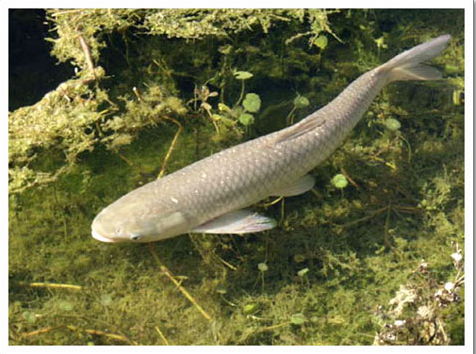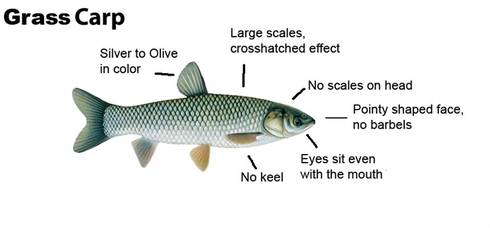June 6, 2019
Triploid Grass Carp
Rick Stuebing
Introduction
The use of Triploid Grass Carp is one of several methods to control the hydrilla in Johns Lake. Triploid grass carp are unique, olive-green, cigar-shaped fish often observed basking in the sunshine in shallow water as they soak up warm surface temperatures. What sets these fish apart from others is their intense appetite for a wide variety of underwater plant life. Often, plant problems in ponds and lakes are due to invasive, exotic species such as hydrilla, which have no natural enemies in Florida. It is in everyone’s best interest to prevent these plants from spreading and taking over our waterways.
Grass carp come from Asia and also have no natural enemies in Florida. The triploid “grass carp” is a sterile version of the white amur. It has been used in private and public Florida waters for the control of noxious aquatic plant species since 1972. Triploid grass carp are considered a natural method for controlling aquatic vegetation and macro-algae. They can live for many years (20 plus years in some cases). Their ability to live long typically makes them significantly more cost effective than herbicides.
Grass carp usually take six months to a year to be effective in reducing problem vegetation, although they provide much longer term control than other methods, often up to five years before restocking is necessary. When used in conjunction with herbicide treatments, control of problem vegetation can be achieved quickly, and fewer carp are required to maintain the desired level of vegetation.
Physical Characteristics
Grass carp are actually members of the minnow family. Grass carp grow to an average of 15-20 pounds and 20-35 inches in length. In larger lakes with large numbers of plants, they can grow up to 50-60 pounds and exceed 50 inches in length. In Florida, the largest reported grass carp weighed 75 pounds.
Grass carp sometimes appear silver in color, but often display an olive green or dark gray hue on top with light gold or pale yellow sides. Their belly is silvery or bluish-white and fins are light green or gray. Unusually large fish scales are another distinguishing characteristic.
Grass Carp Sterility
When grass carp are able to reproduce, they are called “diploid”. Florida law dictates that grass carp used for weed control must be sterile, or “triploid.” “Triploid” grass carp are hatchery-raised fish that have been sterilized by “shocking” fertilized eggs. This leaves the fish unable to produce viable eggs. This technique is used to eliminate reproduction in Florida waters.
Permitting
In Florida, only triploid grass carp are allowed and a permit is always required, even when stocking privately owned waters. Permits may be obtained by contacting the Florida Fish and Wildlife Conservation Commission (FWC).


What They Eat
They are normally readily available for purchase year round in several sizes but require a permit. The smaller ones are cheaper but have a higher chance of being eaten by bass. Most grass carp are shipped at about 11 inches. If stocked at a proper rate, at correct sizes, targeting proper plant species, and the right time, you will achieve significant vegetation control the first year, depending on the severity of the problem.
They prefer softer, pliable aquatic vegetation such as hydrilla and milfoil. Fortunately, hydrilla is their favorite food. This desire for delicate vegetation reduces tendencies to eat most desirable emergent and floating aquatic vegetation species. Grass carp’s selective diet is perfect because it allows floating plants such as watermeal, and emergent species as pickerelweed, lilies and duck potato, to coexist with the fish. This allows these floating and emergent species to both serve as refuge for fish and wildlife, while also helping to manage influxes of nutrients that occur over the growing season.
Plants Preferred by the Grass Carp
- Hydrilla
- Coontail
- Muskgrass
- Naiad
- Slender and jointed spikerush
Plants Preferred by the Grass Carp
- Water hyacinth
- Water lettuce
- Water lilies
- Torpedo grass
- Hygrophila
- Cattail
Conclusion
In May of 2019 FWC added approximately 1,000 sterile grass carp to Johns Lake. 500 were released near the public boat ramp and 500 near the Deer Island Cove. There were also 1,000 stocked in April/May 2015 and 750 in Feb 2016. There is no way to accurately say how many of those carp are alive because we don’t have perfect numbers for stocking mortality (predation by largemouth bass when they are young, etc.). From what some have observed, you start to lose 10-20% per year after age 6 or so. Most do not live past age 10-12.
FWC agreed to stock the additional 1,000 carp because of the way the hydrilla expanded so quickly in September 2018. When you get the right balance of carp, you shouldn’t have to treat with as much herbicide. All lakes are different and the stocking of carp should always be in conjunction with small, sometimes frequent, herbicide treatments.
From an FWC perspective Johns Lake looks great. We have good coverage of submersed vegetation and the water clarity is good. We are seeing an upward trend in our largemouth bass population and noticing more ducks as well.

